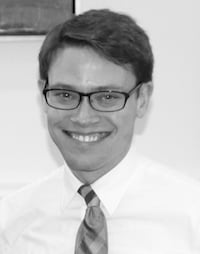
Dr. Robert Kalescky, Computational and Theoretical Chemistry Ph.D. graduate and Southern Methodist University (SMU) HPC Applications Scientist, is responsible for assisting the research community at SMU with their use of the university's high-performance computing resources, primarily ManeFrame II.
An instrumental researcher in the field of Theoretical and Computational Chemistry, Dr. Kalescky credits much of his success in and passion for this discipline to the dedicated and knowledgeable faculty he has encountered, and continues to work with at SMU. Below, he shares his experience as a student and scientist for the university, and offers his wisdom to those considering this field.
Can you tell us a little about your educational background, and what got you interested in studying and researching chemistry at this level? What brought you to SMU?
 I have a B.S in Chemical Engineering from Texas Tech University, an M.S. in Chemistry from the University of Texas at Dallas, and a Ph.D. in Chemistry from SMU. I have been interested in clean or renewable forms of energy for several years, which fostered my initial interested in chemical research. Combined with my interest in programming and computing in general, computational chemistry has been a good mixture of my interests. I was initially drawn to SMU through Dr. Kraka’s expertise in quantum chemistry and her excitement for building computational programs at SMU.
I have a B.S in Chemical Engineering from Texas Tech University, an M.S. in Chemistry from the University of Texas at Dallas, and a Ph.D. in Chemistry from SMU. I have been interested in clean or renewable forms of energy for several years, which fostered my initial interested in chemical research. Combined with my interest in programming and computing in general, computational chemistry has been a good mixture of my interests. I was initially drawn to SMU through Dr. Kraka’s expertise in quantum chemistry and her excitement for building computational programs at SMU.
Did you always want to work/study in this field, or did you have other plans?
Chemistry, programming, and computing have been my primary interests for a long time, and I’ve essentially been working in related fields since my undergraduate days.
Can you describe your involvement with the Chemistry department at SMU?
As the first student member of the Computational and Theoretical Chemistry Ph.D. program, I was involved in many of the group’s initial research projects, but principally I used Konkoli-Cremer local modes for the description of interesting chemical bonding situations. I also assisted in the Computational Chemistry, Introduction to Computational Chemistry, and Computer Aided Drug Design classes. My favorite project was likely our work with the water and formic acid dimers. These weak bonding interactions were surprisingly complex and interesting to explore.
Certainly, the most valuable thing I learned during my time [with the Chemistry department] was the craft of scientific research. This program [was, at the time] led by Dr. Kraka and Dr. Cremer, two of the most dedicated individuals to scientific research, and I had the pleasure of working with them.
What work did you do as a postdoctoral fellow?
I worked with Dr. Tao, also of the SMU chemistry department. For this research, the role of individual protein residues in protein allostery was explored. This led to the development of the rigid residue scan method using rigid body molecular dynamics for probing the significance of a single residue on intra-protein dynamics and allosteric mechanisms.
What do you most think is most unique or valuable about the Department of Chemistry and specifically the CATCO group that exists at SMU?
It is the leadership of the [Computational and Theoretical Chemistry faculty], and their dedication to scientific research and teaching new scientists — that sets this program above all others.
Why do you think Computational and Theoretical Chemistry is an important and valuable field to study?
Computational and theoretical chemistry allows for insight that is sometimes not possible through methods other than modeling and simulation. Through computational chemistry a single molecule can be studied to extreme precision and accuracy, while also millions of molecules can be studied at lower levels of theory. This flexibility makes computational chemistry valuable to many different fields within the whole of chemistry.
Are there any emerging trends or developments in the field of Computational Science that you find exciting?
New types of devices that can perform certain types of computations exceptionally well are proliferating. These devices are generally known as accelerators, with the GPU being the most well-known. Adapting existing computational codes to these new types of hardware is both challenging and interesting.
Is there any advice or wisdom you would pass along to encourage students who are interested in the field?
Peer involvement was a large part of my graduate experience. I was a member of the Chemistry Department’s Chemistry Graduate Council, SMU’s Graduate Student Assembly, and the ACS’s Graduate Student Symposium Planning Committee. Having a group to commiserate on the challenges of graduate student life was beneficial.
My other advice is — to make it your own. I felt that my research experience was greatly enhanced when I took the steps to explore or implement an idea on my own.
If you are interested in learning more about the fields of Theoretical and Computational Chemistry, or in the cutting edge research being done at SMU, we invite you to request more information. Like Dr. Kalescky, you too can make significant contributions to this rapidly evolving field!
